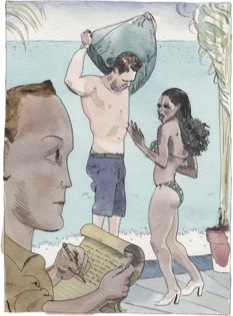
Having spent much of the last week of 2011 out of town and away from my usual, everyday routine provided me prime time to ponder and reflect on things I often otherwise forget about or take for granted. In this unencumbered mindset, I happened upon the following line in a New Yorker piece by James Wood: “At present, the American magazine essay, both the long feature piece and the critical essay, is flourishing, in unlikely circumstances.” The comment caught my eye because it crystallized something I have kind of been thinking myself in recent years (though I didn’t have the audacity or reading range to actually say so).
Folded into a review of a recent collection by the writer John Jeremiah Sullivan,Wood’s central theme is to explore how a new generation of essayists and reporters employs the conventions of fiction writing honed in and usually reserved for “literature.” Indeed, the piece can be read as much as a commentary on the limits of contemporary fiction as of the creative applications of the journalistic, non-fiction essayist. (Wood enlists Milan Kundera and others to develop the point.)
My thinking actually goes in the opposite direction. I am more interested in the parallels and overlaps of the magazine essay with social scientific writing and analysis, especially in its more ethnographic and interpretive forms. I am interested, in other words, in the lessons and applications and provocations of great magazine writing and reporting for those of us working with the methods, conventions, and expectations of social science.
Three points that Wood makes about Sullivan’s representative body of work shaped my reflections. The third, on which Woods spends the most time, is about the nature of reality in contemporary life. (The piece is titled: “Reality Effects.”) Sullivan develops the theme in dialogue with David Foster Wallace’s “lost in the fun house” framing most directly and extensively in context of an extended treatment of the television series “The Real World,” the essay with which I was most familiar. This is a deep and important theme—and has significance and consequence well beyond my end-of-year speculations. But my basic thought was this: we sociologists are both well positioned and absolutely obligated to make a contribution here (especially in connection with our notions of identity and authenticity). Still, we have only done so sporadically and in pockets since the founding of the discipline.
Nonetheless, it was actually the other two aspects of Sullivan’s writing, as rendered by Wood, that really set my mind ranging: his attention to detail and his serious, non-ironic engagement with the subject (and subjects) of religious belief and practice.
The point about attention to detail is a basic one, and Wood gives a number of intriguing and illuminating examples of the kind of details that appear in Sullivan’s writing. (On the theme of attention to important details, I also read with interest Caitlin Flanagan’s review of Joan Didion’s latest book in The Atlantic). Too often in the social sciences, I think, the value of such rich, empirical detail is dismissed as mere description, a way to prove one’s credibility and time in the field. It is much more than this, however: it is crucial to getting inside the worldview and experience of others, the specifics that make their lives and experiences meaningful and consequential, often in ways and for reasons that those of us with different expectations and experiences would otherwise miss or misunderstand. Wood characterized the importance of such an orientation quite well. It shows, he said, “a writer interested in human stories, watching, remembering, and sticking around long enough to be generally hospitable to otherness.”
I really like that last line—“generally hospitable to otherness”—because it is one of the great goals and always amazing accomplishments (when it is achieved) of sociology as well as journalism. It comes through best, at least in Wood’s review, in Sullivan’s piece on a Christian rock festival in South Carolina. I won’t go into the details here except to say that what seems so notable about this treatment—and that of much great journalism—is the ability to enter into such a world on its own terms, to be the outsider within (perhaps as an embedded sociologist), with the goal of creating dialogue and understanding between worlds, leaving each of us enriched and enlarged in our knowledge of the range and complexity of the human experience as a result of the encounter.

Comments